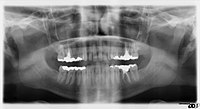
Photo from wikipedia
AIM To describe two patients with X-linked hypophosphatemia presenting with spontaneous signs of pulpal necrosis in multiple intact teeth. The presentation and management are discussed, along with the diagnostic and… Click to show full abstract
AIM To describe two patients with X-linked hypophosphatemia presenting with spontaneous signs of pulpal necrosis in multiple intact teeth. The presentation and management are discussed, along with the diagnostic and endodontic treatment challenges. SUMMARY Two young male patients with X-linked hypophosphatemia were referred to the Department of Restorative Dentistry at the Edinburgh Dental Institute for management of dental infection. Both patients were referred due to their unusual clinical presentation and abnormal root canal morphology. They subsequently presented on multiple occasions with pain or sinus tracts over a 3- and 5-year period whilst under care. Clinical examination revealed intact teeth with buccal swellings, draining buccal sinuses and negative responses to sensibility testing. Radiographic examination, generally consisting of periapical radiographs, revealed intact teeth with a range of unusual morphological features including large pulp chambers, wide canals, short roots and open apices, all with associated periapical radiolucencies. Due to the unusual morphology, some teeth required apexification with a mineral trioxide aggregate plug. Patient 1 underwent root canal treatment on teeth 21 and 43 over a 3-year period. Patient 2 underwent root canal treatment on 10 permanent teeth over a 5-year period. At follow-up, both patients were asymptomatic and clinically the teeth had no signs of infection or periapical inflammation. Radiographic examination confirmed complete resolution of the apical radiolucencies on 11 out of 12 teeth. Favourable outcomes have been demonstrated up to a follow-up of 4.5-years. KEY LEARNING POINTS Patients with X-linked hypophosphatemia may present with 'spontaneous' signs of pulp necrosis in multiple teeth in the absence of caries and trauma posing a diagnostic challenge. Abnormal morphological features, including wide canals and open apices, may present challenges during endodontic treatment. Outcomes demonstrate that an appropriate root canal treatment protocol, including the application of apexification procedures, may be implemented to successfully manage such cases.
Journal Title: International endodontic journal
Year Published: 2021
Link to full text (if available)
Share on Social Media: Sign Up to like & get
recommendations!